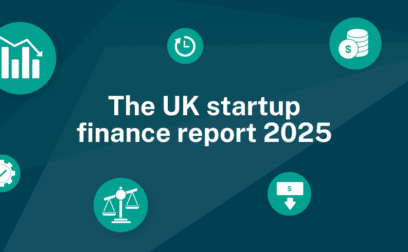Supply chain finance is a co-operation between buyer, supplier, and lender. The lender funds the supplier to help them produce the goods the buyer needs. When the buyer pays for the goods, the supplier pays the lender back. It’s a simple arrangement. But it has a flaw. There are blind spots. At no point can all three parties see what everyone else is doing. Blockchain gives all parties full transparency. The entire transaction is visible to all. By 2028, blockchain use in supply chain finance is forecast to have a global value of US$7 billion, as businesses from giant corporations to SMEs embrace the technology to drive down costs, speed up production, expand trade, and ensure producers maintain an ethical operation.
What is blockchain technology?
A blockchain is an expanding chain of digital records called blocks. They are linked together using powerful cryptography, which makes them very secure. Because every block in the chain has a unique timestamp (denoting when it was created) and an action data, (such as the record of a purchase), the blockchain can provide a high degree of transparency or ‘truth’ in a total transaction. Every person or entity involved with the chain can see backwards and forwards from start to finish. All information is visible.
The most well-known use of blockchain technology is with cryptocurrencies such as Bitcoin, but the technology has other uses, and although it has yet to become universally used in commercial trade, it is well suited to supply chain finance.
How does blockchain work in supply chain finance?
Blockchain technology has moved on from digital money and it is now being used in a wide range of industries including automotive, telecommunications, insurance, retail, entertainment, and healthcare. These types of industry use blockchain features to power various services, from billing and payments to logistics and planning, but their most prolific use is in supply chain finance:
- Standard supply chain financing transaction
Limits visibility to buyer and lender. At each stage of the deal, only two of the three participants – buyer, supplier, lender – can see the activity. Not only does this friction put a brake on production and planning it puts the ‘blind’ party at a disadvantage and may also mask unethical behaviour or financial difficulties for buyer or supplier.
| Transaction phase | Blind party |
|---|---|
| Buyer places order with supplier | None |
| Supplier asks lender for funds | Buyer |
| Supplier bills, ships good to buyer | Lender |
| Buyer pays supplier for goods | Lender |
| Supplier repays lender, closes loan | Buyer |
| Buyer returns unsold goods to Supplier, gets refund | None |
- Blockchain supply chain financing transaction
The entire blockchain is visible to all three parties. As each phase of the transaction occurs, a new block is added to the sequence. No party is blind. All parties can see what stage the transaction is at and may act accordingly – such as ‘just in time delivery’ or production development. It is not possible to obscure unethical behaviour or financial problems, which reduces risks and can lower costs such as insurance or financing fees.
| Transaction phase | Blocks added and visible to all |
|---|---|
| Buyer places order with supplier | Order |
| Supplier asks lender for funds | Order/Loan |
| Supplier bills, ships good to buyer | Order/Loan/Bill/Ship |
| Buyer pays supplier for goods | Order/Loan/Bill/Ship/Payment |
| Supplier repays lender, closes loan | Order/Loan/Bill/Ship/Payment/Repay/Loan/Close |
| Buyer returns unsold goods to | Order/Loan/Bill/Ship/Payment/Repay/Loan/Close |
| Supplier, gets refund | /Returns/Refund |
What are the advantages?
Blockchain technology offers many benefits when applied to supply chain finance:
- Total visibility for all transaction participants
- Better control of complex transactions involving multiple parties
- Improved logistics and timing
- Automated actions reduce need for manpower
- Reduced risk
- Lower costs such as insurance and financing fees
- Less risk of unethical behaviour
- Encourages more lenders to fund more deals
What are the disadvantages?
There are few negatives involved with blockchain I supply chain finance:
- Low take-up by SMEs due to non-scientific bias against blockchain or lack of information
- IT and methodology change for sales teams and buyer departments
- Synchronisation between buyer/supplier/lender trading systems
Is blockchain in supply chain finance secure?
Yes. A blockchain is a digital system (or ledger) for recording transactions among multiple parties in a verifiable, tamperproof way. Each block in the block chain is linked to the next by powerful cryptography. Without the unique access key, it is impossible for anyone outside the transaction to gain access or interfere with the ledger.
An example of blockchain in supply chain finance
Buyer, supplier, lender have sight of each block in the chain. Here’s a simplified example:
- Global Retail places an order for cardboard boxes with ABC Cartons – a box manufacturer.
- The order is inserted into a blockchain established to manage the transaction.
- ABC asks their bank to fund the cost of raw materials to produce the boxes. The bank agrees and they enter a new block in the chain. The action is also visible to Global.
- ABC receives the funds and makes the boxes. They ship them to Global along with the invoice. The bank has sight of the shipping and billing, which are new blocks in the chain.
- Global receives the boxes and pays ABC. Two more blocks are added to the digital ledger. ABC and the bank see these actions.
- ABC repays the bank, and the bank closes the loan record. (Two more blocks).
- Global closes the chain. (Final block).
Blockchain allows automated actions throughout this transaction, eliminating the need for human intervention. From the initial order, and the request for funds, to buying raw materials, shipping, invoicing, paying, and re-paying off the loan, every step of the deal may be managed remotely. This streamlines the process and avoids delays in production, late billing, late payments, duplicate payments and more. The overall result is greater efficiency, which reduces costs and risk and encourages greater participation by lenders with a resulting expansion in trade.
What does blockchain in supply chain finance cost?
Every transaction is unique, which makes it impossible to price blockchain utilisation. However, because the technology removes most manual aspects of the trade, and all parties have full visibility, errors and risk are reduced. This would be reflected in lower fees for finance and insurance and savings on mistakes such as lost orders or over-payments. Blockchain has the potential to make supply chain financing cheaper and more secure than standard financing methods.
How can I find out more?
Supply chain finance is changing. Technology has the potential to expand trade and make funding available for many types of business, not only giant corporations. Discover more about the new face of supply chain finance and how it can support your business needs. Contact us today.
Swoop requires writers to use primary sources to support their work. These include white papers, government data, original reporting, and interviews with industry experts. We also reference original research from other reputable publishers where appropriate.
- Blockchain value in supply chain finance: https://www.verifiedmarketresearch.com/product/blockchain-in-supply-chain-finance-market/
- Blockchain: https://en.wikipedia.org/wiki/Blockchain
- Bitcoin: https://bitcoin.org/en/



































 yet? Register here!
yet? Register here!